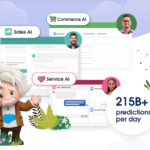
Empowering Retail and Distribution Innovation
Retail and Distribution is one of the most visible parts of the global economy. For consumers, this part of the economy is the world they live in every day.
More than any other industry, retail was massively impacted by the COVID-19 pandemic. Europe, the Middle East, and Africa went into lockdown about March of 2020. In some cases, stores didn’t reopen for a year and a half. Only now, in 2024, are most analysts stating the most of the industry is back on a normal footing.
Retail Revolution with Keonos's Solutions
Definition
In general retail goods include those tangible items that consumers buy, excluding food and fuel. Here is a short list by way of example:
●Apparel
●Books
●CDs and DVDs
●Electronics
●Furniture
●Jewellery
●Make-up
●Perfumes
●Pre-packaged foods
The industry is highly visible and somewhat volatile; for many consumers, these are goods that are not as necessary as food, fuel, and housing. They will tend to stop buying them if the economy is weak.
Global
Growth in the consumer products infused has been driven larger by price increases, not by increased demand or increasing market size. These price increases haven’t hurt the industry, “A Deloitte analysis of the 100 largest public CP companies by revenue, coupled with a survey of 250 global CP executives, finds that top performers were able to raise prices as much as or more than others, with smaller hits to volume and more margin growth.”
This pattern for growth may be played out as consumers are resisting further price increases. According to Oberlo, “In 2024, the retail industry growth is set to hit 4.9%. This increase will bring total retail sales worldwide to $31.1 trillion.”
Oberlo goes on to say, “Growth is expected to continue in the coming years, albeit at a slower rate. In 2025, the retail industry growth rate is forecast at 4.2%—0.7 percentage points lower than this year. According to analysts’ projections, the global retail industry’s growth rate is forecast to decline even more in 2026 and 2027, to 3.8% and 3.6%, respectively. 2027’s growth rate is also the slowest in the forecast period from 2021 to 2027.” Ibid.
EMEA Region
According to CBRE, major European retail markets are expected to grow in line with pre-pandemic trends in 2024, with no accelerated growth. Savills predicts a 3.7% increase in retail sales in real terms in 2024, supported by rising real disposable incomes. BNP Paribas Real Estate also predicts a rebound in retail sales in 2024 in almost all European countries. The COVID-19 pandemic had a lasting effect on how consumers spend, namely there is continued pressure on retailers to provide same-day delivery, easy online shopping, and more.
Retail growth in Europe, the Middle East, and Africa is being driven by greatly slowing inflation. Where some parts of Europe saw double digit inflation in the past two years, that has come down significantly. This allows wages to begin to catch up and for consumers to look more favourably on purchasing items that they might see as unnecessary.
With oil prices somewhat subdued, the Middle East is expected to only see modest growth in retail in the next few years.

Challenges to the Retail and Distribution Industry
1. Inflation
Challenge: Inflation has been a
significant factor in the last two
years. Globally, inflation was 8.71%
in 2022, 6.88% in 2023, and is
projected to be 5.79% in 2024.
According to Statista, inflation
will continue to drop globally to
about 3.83% in 2028
Solution: For both retail and
distribution, the key will be to
implement cost reduction measures.
Taking advantage of artificial
intelligence and other technological
innovations can reduce costs
significantly.
2. Supply chain resilience
Challenge: During the COVID-19
pandemic, the whole world discovered
that our supply chain was filled
with problems. As consumer demand
shifted, the supply chain couldn’t
keep up. According to Deloitte, less
than half of retailers believe they
effectively deal with supply chain
disruptions.
Solution: A visible supply chain is
the answer. Integrating your
manufacturer’s shipping, your
distributor's supplies, your
shipping company’s tracking system,
and your inventory information will
allow you to see where everything
is. Proper inventory control allows
retailers and distributors to
respond to supply chain disruptions
quickly and smoothly. By having a
fully integrated supply chain, every
link in the chain will know
precisely where everything is at and
how to respond.
3.Customer Experience
Challenge: With a lack of larger
markets to enter, many businesses in
the retail and distribution industry
can grab market share by providing
customers with a better experience.
Solution: The key to success is to
increase the company’s digital
presence. Making same-day delivery
possible, shipping directly from the
warehouse, and making returns faster
and easier is the key to garnering
customers’ trust and loyalty. Using
a CRM designed for tracking the
customer journey is the key; every
interaction should reflect what has
gone before, what the customer
enjoys, and recognizes the patterns
of the consumers’ activities.
4. Environmental Sustainability
Challenge: Environmental
sustainability is about more than
simply meeting customers’ wishes; in
many cases, governments are
reinforcing it and companies have
made a commitment to becoming more
sustainable.
Solution: Sustainability starts with
a commitment to ESG matters in the
boardroom and passing that
commitment down to every level of
the company. It’s also important to
pass this commitment horizontally to
one’s partners in the supply chain.
Each company can make commitments to
change how they operate.
Sustainability also offers the added
advantage of usually reducing
long-term costs.
5. Seamless Buying Process
Challenge: Consumers are seeking a
completely seamless buying process.
From the first moment they consider
an item to the final delivery and
follow-up consumers are looking for
everything from a single place in a
single voice. At the moment, even
“simple” functions like being able
to tell customers where their item
is can be outside the norm for many
companies and their supply chain
partners.
Solution: Integration is everything.
At this point, nearly every company
has put some type of tracking in
place. The problem is that most of
the supply chain is siloed, with all
the information the consumer needs
separate from the systems they have
access to. To deliver a seamless
business process, it’s necessary to
create a seamless supply chain
tracking system, then make that
available to the consumer. 4
6.Siloed Marketing
Challenge: One of the most important
functions of a retail firm is
marketing. Without marketing,
getting the message out about what
your business sells and does is
impossible. In many retail settings,
the marketing efforts are siloed
from the rest of the business. The
supply chain, the retail outlets,
the payment services, and even
corporate leadership has no idea
what marketing is doing and how it’s
impacting the rest of the business.
Solution: Once again,
complete integration of apps and
systems is what’s needed. Using a
proper integration app and a data
visualisation program, one can see
how everything is affecting
everything else. Marketing efforts
and how they result in sales can be
easily integrated into other
factors, like supply chain
disruptions, and economic changes.
Retail & Distribution Industry
2024 and beyond
A vital part of the global economy, retail and its supporting distribution network are a bellwether of how well business is doing and how well it adapts to changes. As the global market completely recovers from the COVID-19 pandemic, retail will once again be on pre-pandemic footing. Investments are continuing and business is getting back to normal. Pressures, like inflation and global instability, are contributing to struggles. The key to making sure that the retail and distribution industry remains strong is to increase efficiency and provide the customer with experience they seek. Technology, as with every other industry, is the tool for making this happen. From integration programs and updated systems to supply chain visibility and dynamic pricing, retail has many opportunities to keep profits high with very little effort.







